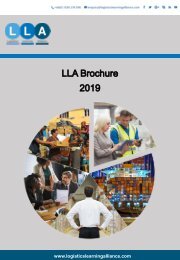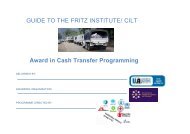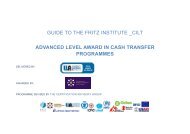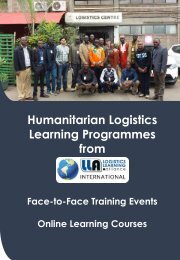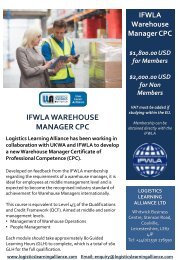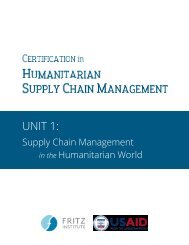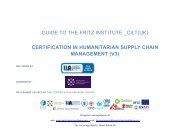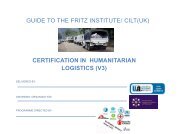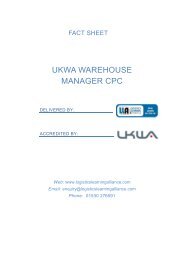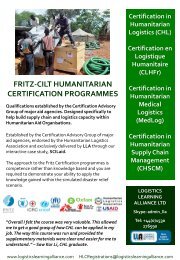CHL Overview - September 2017
Certification in Humanitarian Logistics (CHL) Version 3 - Starts 1st September 2017.
Certification in Humanitarian Logistics (CHL) Version 3 - Starts 1st September 2017.
Create successful ePaper yourself
Turn your PDF publications into a flip-book with our unique Google optimized e-Paper software.
CERTIFICATION IN HUMANITARIAN LOGISTICS (<strong>CHL</strong>) PROGRAMME<br />
UNIT 5: Fleet Management<br />
This unit examines the function of fleet management in<br />
humanitarian supply chains, the selection of vehicles and equipment<br />
and the setting up of systems and procedures necessary to monitor<br />
and manage a fleet of vehicles. It relates to the management of<br />
vehicles involved in the movement of goods, the management of<br />
light vehicle fleets used in the transportation of people and light<br />
cargo, possibly motorbikes and also other equipment such as<br />
generators and warehouse handling equipment. The fleet<br />
management function involves acquisition and subsequent<br />
management of the necessary assets and associated, often<br />
significant, resources that enable a humanitarian organization to<br />
achieve its organizational objectives.<br />
The aim of this unit is to provide the foundation skills and knowledge in the function of fleet management<br />
performed by people working in logistics/supply chain in humanitarian organizations. The unit will help<br />
develop an understanding of:<br />
❖ The function of fleet management;<br />
❖ Fleet management systems and procedures;<br />
❖ Planning a fleet to meet programme needs;<br />
❖ Processes for selecting suitable vehicles, equipment and facilities;<br />
❖ Procedures for repair and maintenance and the value of preventative maintenance<br />
systems;<br />
❖ Systems for measuring and monitoring the performance of the fleet;<br />
❖ Recruitment selection and management of drivers;<br />
❖ Compliance with legislation and security requirements; and,<br />
❖ The management of non-vehicle assets.<br />
UNIT 6: Cash Transfer Programming (CTP)<br />
Cash transfer programming (CTP) is the standard term used to refer to humanitarian programmes using cash or<br />
vouchers as the mode for assisting beneficiaries in preference to direct aid. Alternative terms for the same type<br />
of programming are ‘cash-based interventions’ (CBI), ‘cash and vouchers’, and simply ‘cash’.<br />
CTP has been around for some time but suddenly technology has enabled the agencies to offer this as a<br />
realistic mode for delivering aid. Donors, one of the key components of a humanitarian aid programme along<br />
with the beneficiaries, are asking for cash as a modality. For example the UK DFID asks “why not cash?” So, the<br />
humanitarian logistician has to understand the reasons why CTP might be used, the processes involved in<br />
getting to those decisions and their role in implementing them. This unit covers:<br />
❖ Assessments, Analyses, & Building to Decision Making<br />
❖ The Retail Market Assessment<br />
❖ The Procurement Options Analysis<br />
❖ The Operational Design Options Analysis<br />
❖ Feeding Into the Programme Analyses




